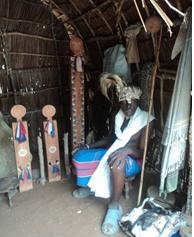Mijikenda oral histories relate that the ancestors of
today’s Mijikenda people who migrated from Shungwaya; a place believed to be
north of Tana River and South of Juba River in Somalia. Mijikenda is a Swahili word
meaning nine tribes. They are closely related and speak almost similar Bantu
dialects sharing some vocabulary. These tribes are: -
Giriama, Digo, Duruma, Chonyi, Ribe,
Rabai, Kambe, Kauma and Jibana
The Mijikenda lived with other groups including
wa-Taita, wa-Pokomo,wa-swahili, wa – Ghalla.
Hando – Women’s skirt
Shuka – Men’s Loin Cloth
 |
| Blue Hando worn by diviners |
Hando is a popular traditional skirt worn by Mijikenda
women. Traditionally it was worn as a knee length skirt, especially in the
public to show respect by not exposing body parts that were regarded as
private. The Hando was made from cotton fabric in the following process:-
- Pull threads along the grains of fabric in one direction to fray the fabric.
- It is then soaked in water and while wet, beaten against a tough surface, mostly stone or wood and sometimes in a mortar & pestle to soften the thread strands.
- The tangled threads are then combed through to straighten using a wide toothed wooden comb (mkowa).
There are 2
types of skirts
Hando – Regarded as special, dressed in any place at home and on safari. It
is also reserved for very special occasions like community ceremonies. Elderly
women prefer hando because it is longer and some of them posses special talents
such as spirits and divining power.
Bandika -This is a less special type of hando made from
mixed coloured fabrics referred to
as f Calico and commonly worn at
home, it is also gaining popularity as a dance costume, it is therefore made
slightly shorter than the hando to ease movement when dancing. Younger women
interested in exposing their bodies prefer this type of skirt
When visiting places where one needs to show respect
by covering nakedness, bandika is worn with a longer wrap underneath. In the
past, these skirts were worn without anything to cover chests, but with
improvement, a matching cotton fabric is tied to cover nudity.
Women of any age can wear hando but restrictions are
imposed on colours that are significant to practices that the community
associates with as follows.
White
Hando ( Hando ra ruhe/ Bafuta) –
popular during cultural wedding/marriage ceremonies. It has no restriction to
particular age groups.
 |
| Hando - Mijikenda Women's Skirt |
Red
Hando (Hando ra Ngundu/Tune) –
this colour is associated with spirits; it is commonly worn by women who are
thought to possess spirits. It is believed that a grandmother can pass over
spirits to a daughter or granddaughter and recommend that they dress in the red
coloured hando. (Women with spirits wear their hando with a mix of blue, white
and red coloured beaded bracelets and sometimes with talisman (hirizi)
Blue Hando (Hando ra Msimbiji) - this is worn by diviners to enable the rest of
community members identify them by their role of divining & traditional
healing.
Hando ra Kaputula – this style of hando would be of mixed colors of
lesso fabric, prepared like all the others but worn very short like miniskirts.
It was popular among young girls and fashion conscious ladies who prefer short
to long.
The hando was worn with other adornments such as:-
- Aluminium Arm bangles /Bracelets – worn around wrists and molded from old aluminum cooking pans by traditional Mijikenda blacksmiths.
- Tunda – this is made from strands of coloured beads( usually red, yellow and white) intertwined around the waist
- Brass or bronze Necklace – Mkufu
- Beaded Arm bands - Vivorodete – worn in pairs by married women around the arms above the elbow during social meetings, ceremonies and festivals.
- Ankle Bangles – Vidanga
- Tsango - coiled aluminium wire worn around the arm below the elbow by girls and unmarried women. Popular during dances and when visiting relatives.
- Earnings – Vifufu – molded from aluminium
Men wore white loin cloth called shuka and nothing
else on top. However as a mark of recognition, elders with special
responsibilities in the community also wore them. These are: -
 |
| Shuka - Men's Dress |
Vaya-elderly men who
dealt with politics and governance
Gohu – Elderly men of a secret society responsible for oaths & medicine men. The elders wore kitambi/kaniki on the waist. Kitambi could be a blue colored kikoy with red bands on the top and bottom.
Gohu – Elderly men of a secret society responsible for oaths & medicine men. The elders wore kitambi/kaniki on the waist. Kitambi could be a blue colored kikoy with red bands on the top and bottom.
Kaniki – a plain blue or black colored calico strands tied around the waist to form a dress piece known as mkumbuu
Amba/yamba – A long white piece of Calico shawl flipped on the shoulders.
Both men and women styled their hair in dreadlocks.
Information collected from
Emmanuel Munyaya
Kadzo Ngumbao Nzai (Tetemeko dance
group).
Compiled by Doris Kamuye – Librarian –
Webb Memorial Library, Malindi Museum









